'My City' play review that creates a city that is more prosperous than anyone else by laying out puzzle-like buildings

Arclight Games will release a complete Japanese version of 'My City,' a game that develops your own city by laying buildings shaped like
Mystic Full Japanese | ArclightGames Official
https://arclightgames.jp/product/%E3%83%9E%E3%82%A4%E3%82%B7%E3%83%86%E3%82%A3/
In addition, this game adopts a legacy system that cannot be undone once played. The reviews include some spoilers, so be careful if you want to play without knowing anything about the content.
The package of 'My City' looks like this.

The target age is 10 years old and over, the number of players is 2 to 4, and the play time is assumed to be 30 minutes per game. This time we will play with 4 people.

The contents are a rule manual and a game board.

On the player board, a grassland with a river flowing between forests and mountains is drawn, and it is divided by a grid of 11 rows x 11 columns.

And the puzzle pieces lined up on the player board. The building is drawn in three colors: red, yellow, and blue.

At first glance, the puzzle pieces look like the Tetriminos that appear in the puzzle game 'Tetris', but some of them have shapes that you have never seen in Tetris.

There are 24 building cards with each puzzle piece drawn on them.
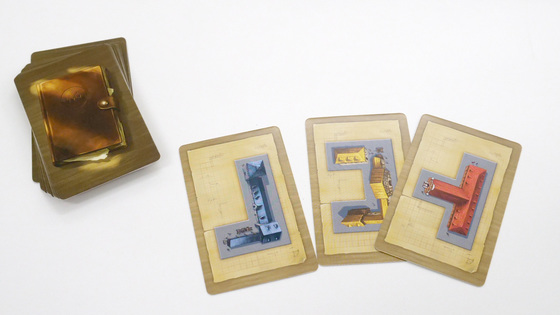
There are four victory point markers.

And there are 8 envelopes with the game scenario written on them. The first envelope says 'Chapter 1 New Earth'.
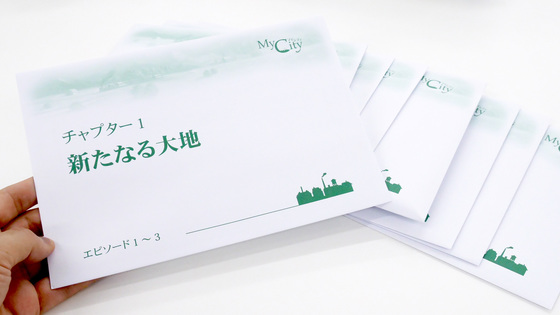
First, distribute one game board to each player and place a victory point marker on the '10' square of the victory point track with the numbers written on it.

Next, we will distribute the puzzle pieces. Turn the distributed puzzle pieces face up. It is convenient to arrange the puzzle pieces by color.

On the back of the puzzle piece, one of the four animal icons is drawn. This icon corresponds to the icon on the upper left of the game board, and the puzzle pieces distributed to each player are only those with the same icon as the game board. In other words, a large number of puzzle pieces are not common, and each player uses a unique one.

Then shuffle the building card with the puzzle pieces and place it in the center of the desk.

Now you are ready. With only boards, panels and cards, the setup is quick.
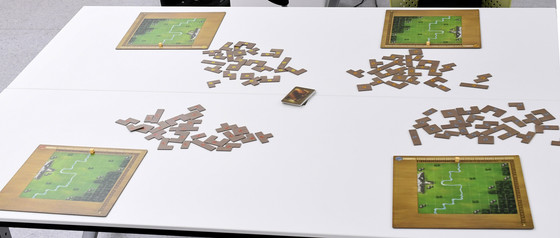
To start the game, first open the envelope that says 'Chapter 1 New Earth'.

There is one sticker sheet in this ...

Contains two sheets that summarize the rules. Each chapter consists of 3 episodes, and rules are added little by little as the episode progresses.

At first, we will proceed with the most basic game rules. The rules are very simple, if you flip one card from the building card deck in the center of the table ...

All players simply place the puzzle pieces written there on the game board at the same time. However, ' the first piece should be placed along the river ', 'the puzzle piece cannot be placed across the river ', 'the second piece should be placed adjacent to the already placed puzzle piece ', and ' forest'. And there is a condition that puzzle pieces cannot be placed on mountain squares. '
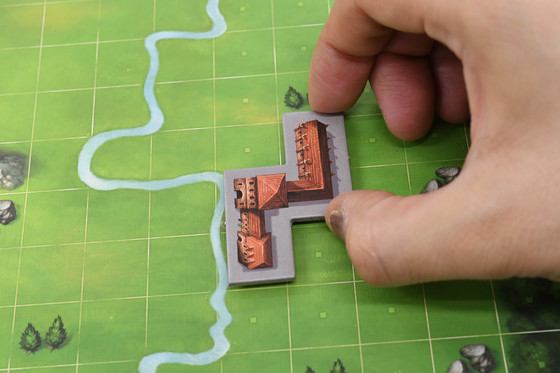
The second one is a T-shaped blue building.
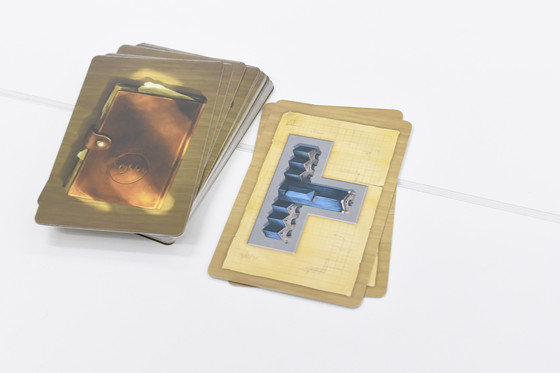
Place the puzzle piece of the T-shaped blue building next to the S-shaped red building that was installed just before. I couldn't put it in the forest, but I could just put it so that it fits snugly between the red building and the forest.
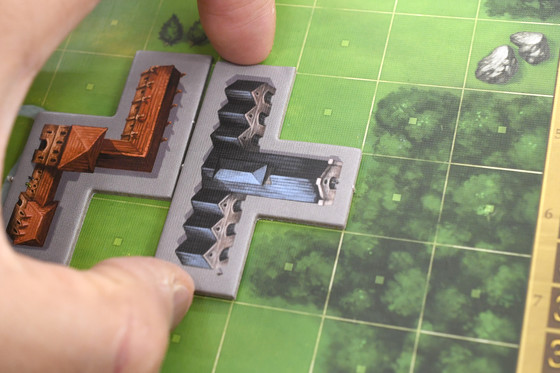
I will arrange the puzzle pieces on my game board like that.

However, when arranging puzzle pieces in a limited area, it may be said that 'this puzzle piece cannot be arranged a little'.

In such a case, you can declare the 'pass' by turning the puzzle piece you were planning to place face down. However, as a penalty, you must deduct 1 victory point for each pass.

Then, if you think 'which puzzle piece may be tough,' declare 'get out of the episode' and flip all the remaining puzzle pieces to get out of the game. You will not lose victory points if you exit an episode, but you will no longer be able to play the game in that episode.

I will spread the puzzles like this. The game ends when all building cards are flipped over or all players exit the episode.

When the game is over, the points will be calculated. In the score calculation, 'number of trees x 1 point' is added to 'victory point track score', 'number of rocks x 1 point' is deducted, and 'number of light green squares in the grassland x 1 point' is deducted. Will be the result. For example, in the following case, the victory point track has 10 points, 2 x 3 = 6 trees, 2 x 1 = 2 rocks, and 5 light green squares. Therefore, this time the result is 10 points + 6 points-2 points-5 points = 9 points.
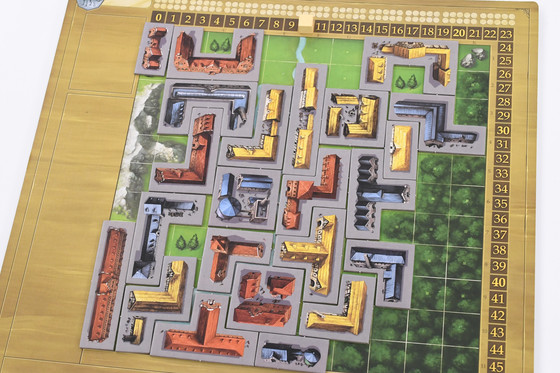
You will be rewarded by deciding the ranking based on the victory points among the players. Victory rewards vary from episode to episode, this time with 2 round 'progress squares' at the top of the game board in 1st place and 1 progress square in 2nd place.

In addition, 2nd to 4th place can receive a sticker to be put on the game board. The 3rd and 4th places, which were unfortunately defeated, won the seal, which is the square of the tree that is the source of the score. It can be attached to any light green square with a small square on it.
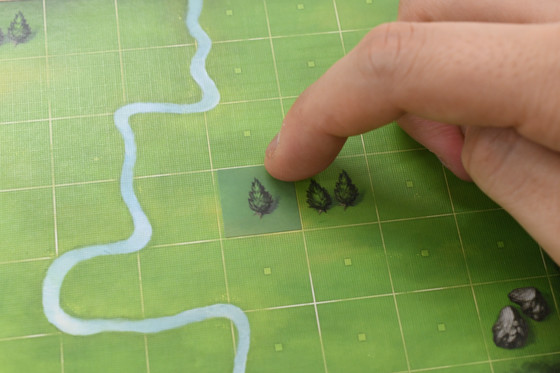
Score calculation will increase as the episode progresses. At first, you are required to fill the game board and reduce the deductions, but in one episode, 'When you put puzzle pieces of the same color next to each other, the number of the largest group of each color becomes the point as it is'. A rule has been added. For example, on the board below, we succeeded in connecting 7 blue, yellow, and red puzzle pieces, so we got 8 points + 7 points + 7 points = 22 points of victory points. Arranging with attention to color as well as shape leads to a big score.

Also, the 'well' added to the game board by sticking a sticker is ...

If you are surrounded by 4 puzzle pieces as shown in the image below, you will get 4 victory points. However, being surrounded by four puzzle pieces means that 'one puzzle piece is adjacent to each side of the well', so it is more difficult to arrange the buildings so that they meet the conditions.

In addition, 'Church' puzzle pieces and cards, and block cards have been added.

Block cards are mixed in building cards. If you draw a deck and a block card comes out ...

Turn over the next card. This time, it's a card of a blue building with 2 squares.

This same puzzle piece cannot be used. Block cards make it impossible to use one puzzle piece.
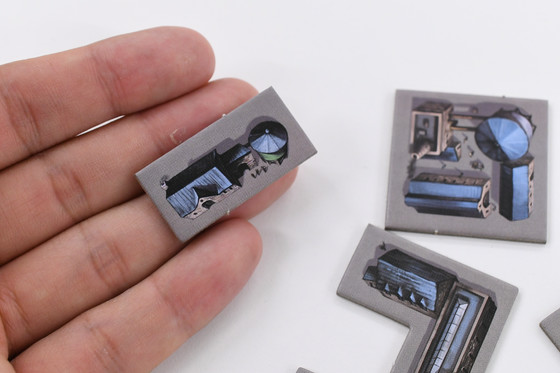
In the church, 3 types of puzzle pieces are distributed to each player, and 3 building cards are mixed in the deck. If you draw a building card and a church appears, you must install a puzzle piece for that church. For example, in the following scene, I drew a cross-shaped church building card.

I look at the game board, but no matter what I do, there is no place to put the puzzle pieces of the cross-shaped church.

However, the rule is that church puzzle pieces can never pass. In other words, you have to forcibly exit the episode when you can't put it. The player muttered a grudge, 'I don't need a church in our city ... Destroy the church ...', flipped all the puzzle pieces over, and got out of the episode.
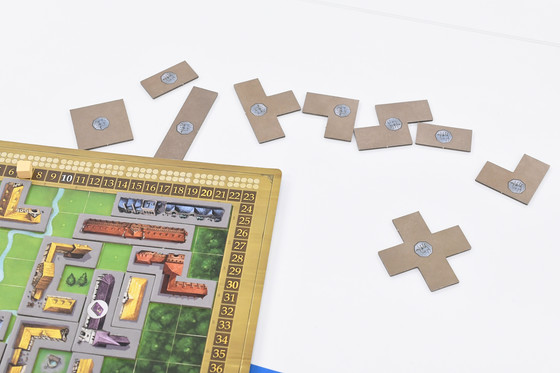
However, the church is by no means an obstacle to the city. As the game progresses, a rule will be added that says, 'If one or more buildings in three colors of red, blue, and yellow are adjacent to each other in the church, you will get 3 points,' which is a reliable source of points.

In that case, instead of the player, he will arrange the church and earn points while saying 'The church is important after all' and 'Because those who believe will be saved'.

In addition, as a reward after the game, a sticker that can increase the victory points of the puzzle pieces of the church from 3 points to 5 points will be distributed, so the importance of the church will be further improved.

However, the increase in church puzzle pieces means that it is difficult to place regular puzzle pieces. You need to be more careful about how you place the puzzles than ever before.

However, as the game progressed, a big flood occurred in the river ...

Puzzle pieces can no longer be placed on the left side of the game board across the river. However, since puzzle pieces can now be placed in forests where puzzle pieces could not be placed, the degree of freedom in placing puzzles has increased dramatically.

And when the water drained, gold mines could be dug on the left side of the river.

In addition, a module of shelves for arranging gold ore will be added to the game board.

The gold mine also appears in the upper right corner of the game board.
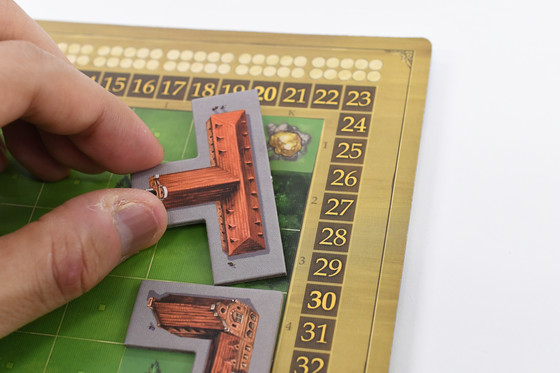
The player who first puts the puzzle piece on the two gold mines on the game board shouts 'Gold mine domination !!'.

Players who successfully conquer the gold mine will be given a gold ore in the shelf module.

At the beginning of the game, My City has a lot of restrictions on how to place puzzle pieces and how to earn victory points, but as the game progresses, more rules will be added and more things can be done. The freedom of how to place the puzzle pieces will increase dramatically, and you will have more thoughts, but the joy of spreading the puzzles freely will make you feel comfortable playing the game.
It takes about 20 to 30 minutes to complete one episode. The rules of the game itself are insanely simple and even beginners can play. Since it is a legacy game, once you play it, you can not play it from the beginning, but even if you clear all the chapters, you will be able to play freely in the mode called 'eternal mode', so you will continue to play even if you clear the prepared episodes It is possible.
The full Japanese version of My City is available on Amazon.co.jp and can be purchased for 3955 yen including tax at the time of article creation.
Amazon | Mystic Full Japanese Board Game | Board Game | Toys

Related Posts:







